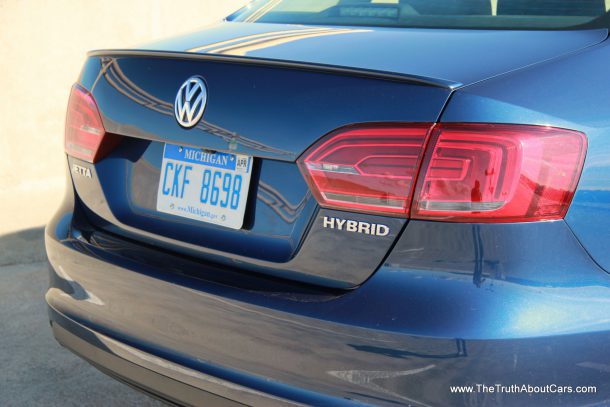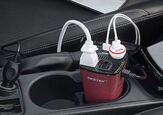Auf Wiedersehen: Volkswagen Quietly Kills Sole Hybrid Model

If you’ve long since erased the Volkswagen Jetta Hybrid from your memory bank, don’t worry. Buyers forgot about it at the same time, and the automaker is prepared to do the same.
When Volkswagen rolled out a list of changes to its 2017 year vehicles today, the Jetta Hybrid was nowhere to be seen. Instead, the automaker placed a note in its empty chair, reading “Jetta Hybrid no longer available.”
It was an undignified (but not unexpected) end for a very unpopular model — one the automaker doesn’t need weighing it down as it tries to streamline its operations in a bid to save cash.
As the automaker’s sole hybrid offering in the United States, the Jetta Hybrid made more sense as green window dressing than it did as a marketable vehicle. Buyers agreed. Entry-level Jettas started pretty cheap for a German car, and the now-maligned (and recalled, and soon-to-be crushed) TDI models offered better power and great mileage for less money. Even now, a Jetta equipped with the fuel-sipping 1.4-liter gas engine is an attractive and economical choice.
Would you buy an unremarkable hybrid version of an existing compact for $31,940 in 2016?
Sales of the model tanked right from the start. In 2013, the Hybrid recorded 5,655 sales, followed by 1,939 in 2014 and 740 in 2015. As of the end of May, Volkswagen only sold 227 Jetta Hybrids this year. The public let their absence do the talking, and Volkswagen listened. (VW isn’t the only automaker struggling with low demand for hybrids.)
With diesel models sidelined and the hybrid gone, Volkswagen’s lineup is now all gas, with the exception of the EV version of the Golf. The company insists that will change. In its long-term plan, which maps out the company’s actions over the next decade, the automaker said it would roll out over 30 battery electric models between now and 2025, but possibly at the expense of 40 other models.

More by Steph Willems
Latest Car Reviews
Read moreLatest Product Reviews
Read moreRecent Comments
- SCE to AUX How well does the rear camera work in the rain and snow?
- MaintenanceCosts The Truth About Isuzu Troopers!
- Jalop1991 MC's silence in this thread is absolutely deafening.
- MaintenanceCosts Spent some time last summer with a slightly older Expedition Max with about 100k miles on the clock, borrowed from a friend for a Colorado mountain trip.It worked pretty well on the trip we used it for. The EcoBoost in this fairly high state of tune has a freight train feeling and just keeps pulling even way up at 12k ft. There is unending space inside; at one point we had six adults, two children, and several people's worth of luggage inside, with room left over. It was comfortable to ride in and well-equipped.But it is huge. My wife refused to drive it because she couldn't get comfortable with the size. I used to be a professional bus driver and it reminded me quite a bit of driving a bus. It was longer than quite a few parking spots. Fortunately, the trip didn't involve anything more urban than Denver suburbs, so the size didn't cause any real problems, but it reminded me that I don't really want such a behemoth as a daily driver.
- Jalop1991 It seems to me this opens GM to start substituting parts and making changes without telling anyone, AND without breaking any agreements with Allison. Or does no one remember Ignitionswitchgate?At the core of the problem is a part in the vehicle's ignition switch that is 1.6 millimeters less "springy" than it should be. Because this part produces weaker tension, ignition keys in the cars may turn off the engine if shaken just the right way...2001: GM detects the defect during pre-production testing of the Saturn Ion.2003: A service technician closes an inquiry into a stalling Saturn Ion after changing the key ring and noticing the problem was fixed.2004: GM recognizes the defect again as the Chevrolet Cobalt replaces the Cavalier.fast forward through the denials, driver deaths, and government bailouts2012: GM identifies four crashes and four corresponding fatalities (all involving 2004 Saturn Ions) along with six other injuries from four other crashes attributable to the defect.Sept. 4, 2012: GM reports August 2012 sales were up 10 percent from the previous year, with Chevrolet passenger car sales up 25 percent.June 2013: A deposition by a Cobalt program engineer says the company made a "business decision not to fix this problem," raising questions of whether GM consciously decided to launch the Cobalt despite knowing of a defect.Dec. 9, 2013: Treasury Secretary Jacob Lew announces the government had sold the last of what was previously a 60 percent stake in GM, ending the bailout. The bailout had cost taxpayers $10 billion on a $49.5 billion investment.End of 2013: GM determines that the faulty ignition switch is to blame for at least 31 crashes and 13 deaths.It took over 10 years for GM to admit fault.And all because an engineer decided to trim a pin by tenths of a millimeter, without testing and without getting anyone else's approval.Fast forward to 2026, and the Allison name is no longer affiliated with the transmissions. You do the math.


































Comments
Join the conversation
My 2016 Jetta 1.4t which I purchased for $17,000 (VW was hurting in March) new returns 40+ mpg and 184 ft-lbs of torque - why would I fuck with a hybrid or diesel for thousands upon thousands more dollars?
I actually saw a Jetta Hybrid on the road the other day. Startling to see the hybrid logo on the trunk of a VW. No doubt stopping production of this sales flop makes sense for a maker who needs to reduce inventory and production costs. It also makes sense in the context of Germany's decision to limit sales of new cars to electric-only as of 2030. Was THAT reported on TTAC? Norway and Holland have banned new non-hybrids and ev's as of 2025. The writing is on the wall for ICE cars. Why develop and sell hybrids (and diesels) when you're going to need the resources to develop pure ev's.